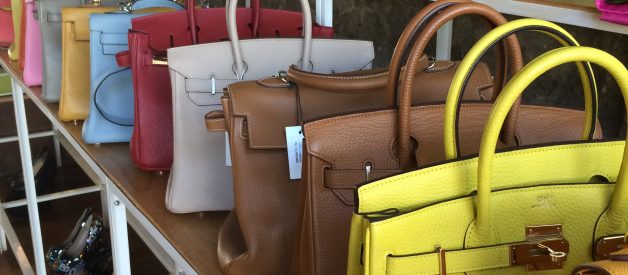Yes, it?s a thing. And it?s a huge problem.
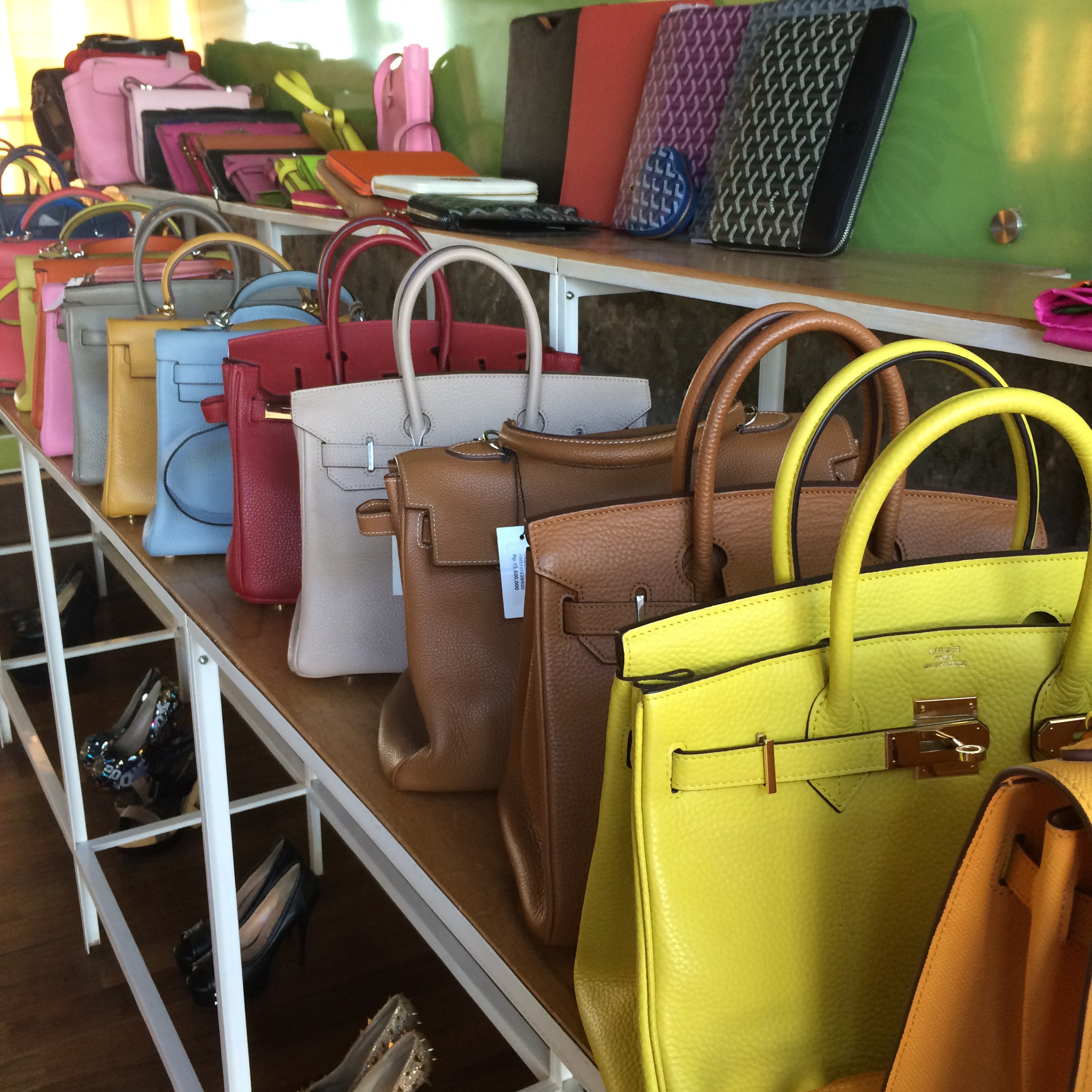 Counterfeit Hermes and Goyard handbags and accessories
Counterfeit Hermes and Goyard handbags and accessories
Most people today are completely unaware of the serious issues behind the enterprise of counterfeit fashion goods, particularly within the designer handbag and accessories market. Breaking the law with a replica bag is justified with claims like ?sellers are just giving people what they want at a more affordable price?, and ?I?m just carrying it for a little while, I can?t afford the real thing?, and ?the luxury companies have so much money so they aren?t really being hurt.?
One of the biggest issues facing consumers in the luxury market is the sheer volume of illegal designer goods like Louis Vuitton handbags and Gucci bags (you may have seen them on Instagram).
How are consumers supposed to know the difference between a real, authentic designer bag and a fake? Why is it illegal? And does it even matter?
For decades, tourists used to flock to New York City?s Canal Street to look at knockoff handbags from sellers discreetly whispering designer names like ?Gucci? and ?Louis?, then leading them into back rooms filled with plastic-wrapped purses. You may remember the Sex and The City Episode where Samantha and Carrie buy a fake Fendi out of the trunk of someone?s car in LA. These are more obvious examples.
A woman walks down the street with a Louis Vuitton look alike that her friend gave her as a gift. People have found themselves in embarrassing situations when their fashion accessory was discovered to be a fake or a counterfeit item ? like that time the store manager at Tiffany & Co. had to pull me aside to tell me necklace an ex gave me ?appears to be a counterfeit Tiffany & Co. piece? and that I needed to leave the store immediately (is my privilege showing?).
What I?m trying to say is that even the smartest shoppers ? even the ones that do their research ? can get fooled by counterfeits. Counterfeiters are savvy these days.
In my own world travels through Southeast Asia, Northern Africa, and Mexico, I?ve witnessed all kinds of counterfeits.
One boutique in Bali, Indonesia had rows of candy-colored leather ?Hermes? bags for $500. The leather felt supple and the bag felt sturdy, and I could see my reflection in the hardware. I could have been fooled, had I not known better.
I spent 9 years of my career obsessively researching and studying the authenticity of luxury handbags for a family-owned designer resale site, Yoogi?s Closet. I?ve spent hours in Louis Vuitton and Chanel boutiques, inspecting handbags and small leather goods while unsuspecting sales associates try to convince me to spend $6000 on a Chanel quilted flap bag. I?ve written training guides about how to authenticate handbags and clocked in my 10000 hours on PurseForum and Facebook groups, reading about authenticity and people?s experience with buying and selling authentic bags online. Every day, I?m more surprised by how easy it is to get tricked online by buying a fake Louis Vuitton or Gucci bag. If it?s confusing for me, as a luxury handbag buying expert, then I?m sure it?s confusing as hell for a regular consumer.
How to completely avoid buying counterfeit luxury goods: always purchase from an authentic brand boutique (a Louis Vuitton store) or a licensed retailer (Neiman Marcus, Saks Fifth Avenue, Barneys, Net-a-Porter).
Knockoffs vs. Counterfeits
Before we go even further, I?m not talking about ?inspired by,? knockoff designs ? which is another issue entirely. Designs of handbags, jewelry, and shoes themselves are not protected by copyright law, although designers continue to lobby to change this. For example, if you purchased a bag that is shaped like an Hermes Birkin bag (like these Teddy Blake knockoffs that sell for about $600 a bag), you are not necessarily carrying an illegal fake ? it may just be knockoff or a blatant copy, which is not technically illegal, but ethically questionable.
However, if a bag has the brown LV Monogram logo print all over it, or if CHANEL is engraved on the zipper, is claiming to be the real thing, and costs $150 from a little boutique on a side street in NYC, it?s counterfeit.
There are really terrible counterfeits that are made of plastic and sold out of stalls with floor-to-ceiling purses that look a ?little off? where you haggle with the seller, face to face (the price starts at $200, but you can walk away with it for $40). These pieces look cheap and look fake. You know, like a Rolex sold out of a suitcase.
I?ve encountered stores in both the USA and abroad that merchandise their store displays like a high-end boutique. Placed high on shelf behind a counter is a Chanel-like black quilted flap bag with a gold CC turnlock and chain straps; the price scribbled onto small paper hang tags, affixed to its shiny hardware on a small string. The price? $250.
I?m referring to replicas, fakes, and counterfeit designer bags, shoes, clothing, jewelry, and watches that claim to be something they?re not with the use of logos, branding, and hardware.
I?m talking about replica Louis Vuitton bags sold out of stalls in Mexico, Marrakech, and Indonesia; Rolex watches and Gucci bags sold on Instagram and WatsApp. Facebook Marketplace is rampant with fakes ? shady retailers can post products there and complete a transaction by directing shoppers to a landing page.
The following photos were taken of counterfeit designer bags from my travels through Indonesia:
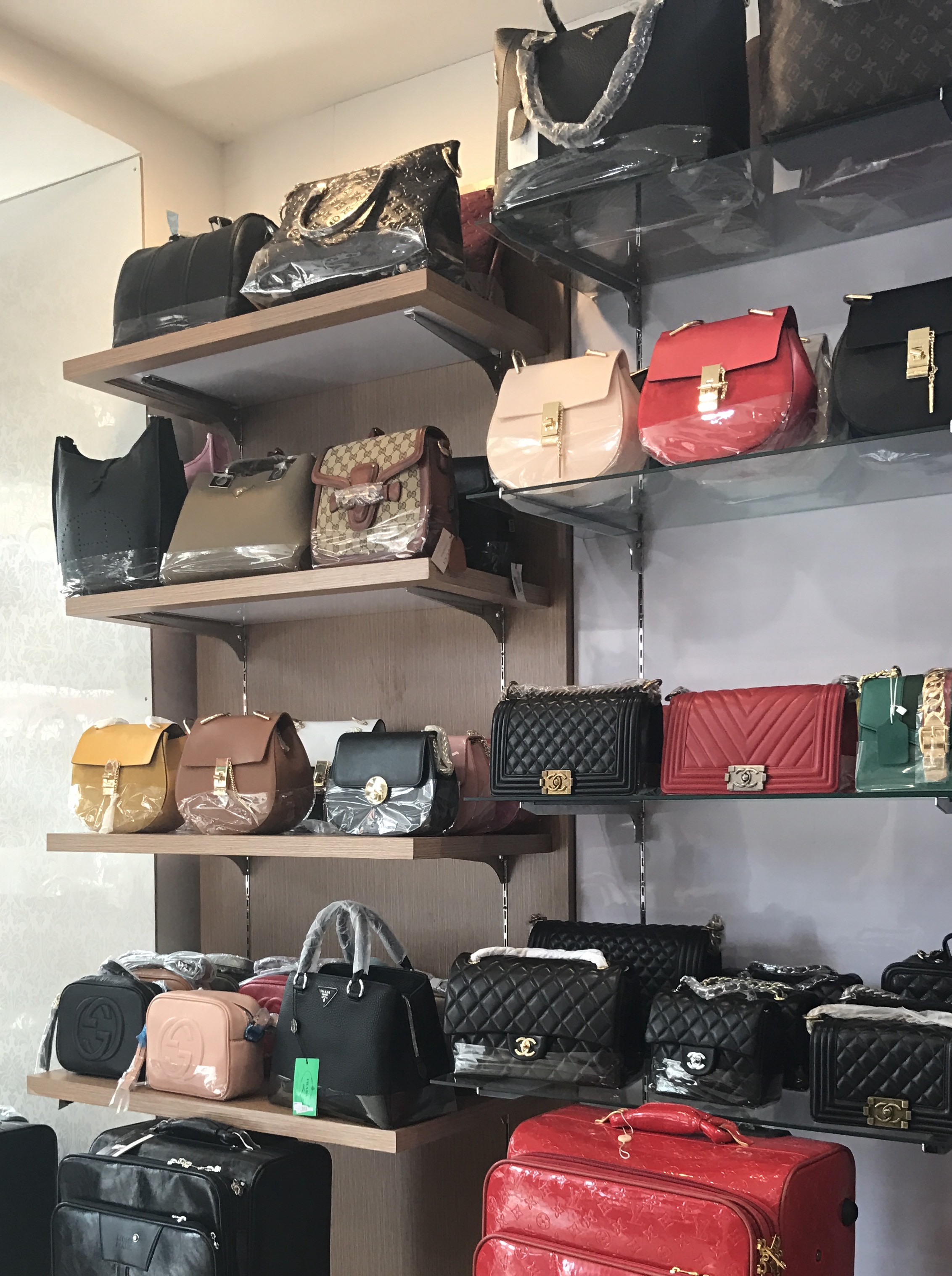
 Counterfeit handbags in Indonesia. Photo by Becca Risa Luna.
Counterfeit handbags in Indonesia. Photo by Becca Risa Luna.
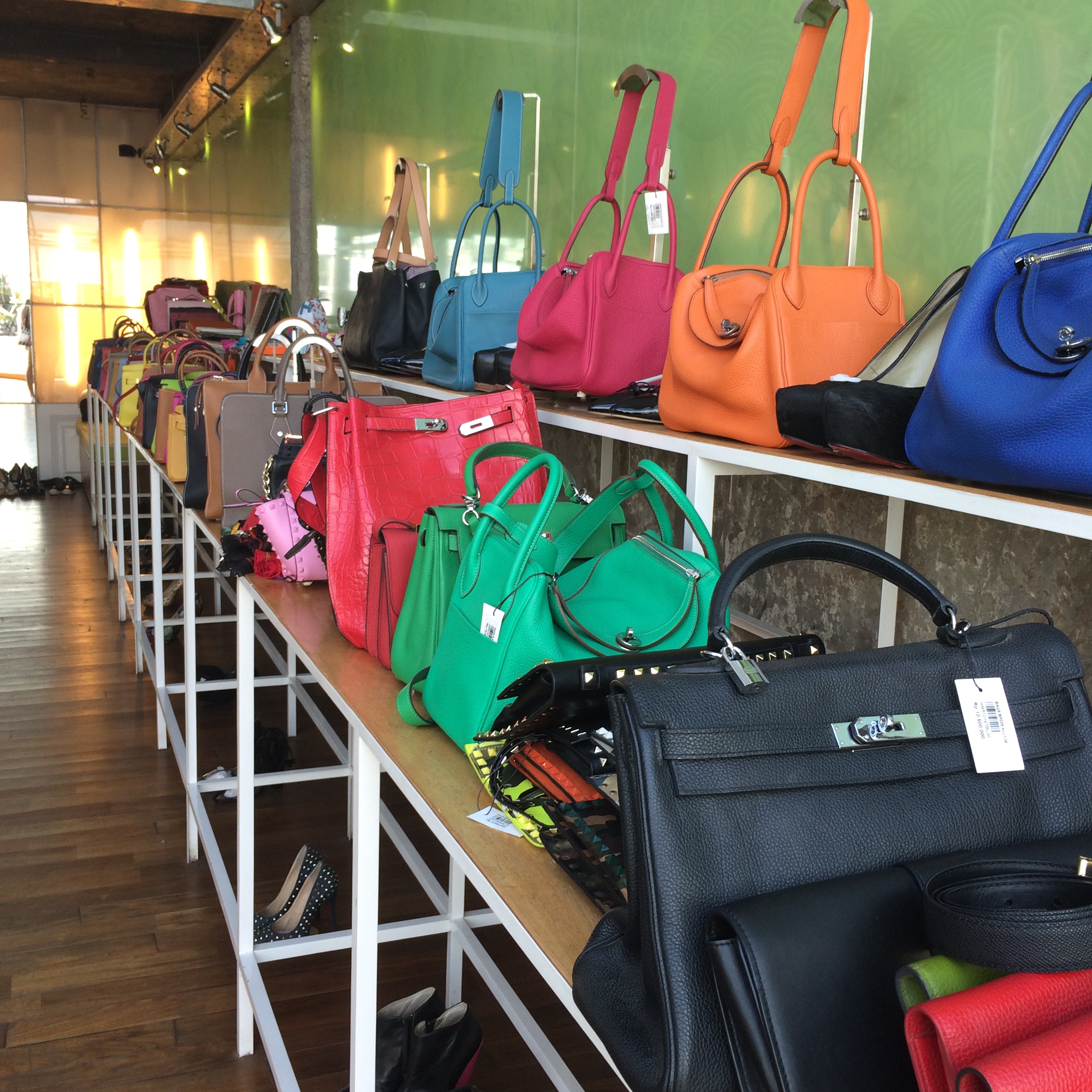 Counterfeit Gucci, Balenciaga, Louis Vuitton, and Hermes bags
Counterfeit Gucci, Balenciaga, Louis Vuitton, and Hermes bags
The REAL Truth About Counterfeit Handbags
You might be asking yourself: what?s so wrong with buying fake goods? Does it even matter? Should we really care if our fashion blogger friend is wearing a Gucci goof or Yeezy dupes?
I?ll start this article with some legal definitions. If legal stuff is boring to you, keep scrolling? but to me, this is essential to understanding counterfeiting and copyright infringement. The purpose of this article is to bring awareness regarding the severity of this issue.
The reason the making and selling of counterfeit merchandise is illegal is because it violates trademark and copyright law. The current trademark legislation in the United States of America is the Lanham Act which prohibits trademark dilution and trademark infringement.
Trademarks are names, phrases, designs, or marks that identify the source and manufacturers of products to enable the public to identify the sources of merchandise. Trademarks allow the public to distinguish one company?s products from another. By obtaining a federal registration from the Patent and Trademark Office, it makes it illegal for another to use that same registered trademark. Each state also has its own trademark laws, as do most countries outside of the United States. Infringements are based on the ?likelihood of confusion? standard.
The copyright law in the United States is governed by the Copyright Act of 1976. Under the Act, it is illegal to copy a work registered by the owner of the work. Protection is automatic since registration is not required. A copyright is the right of an author of an artistic work, or other production that falls within a specified category, to have the exclusive use of that work for a given period of time. Like trademarks, copyrights can also be registered by the Copyright Office in the Library of Congress, but registration is not required.
What is a counterfeit, exactly?
There are a few key elements at play, all of which must be met for something to be deemed a counterfeit) at play. (These elements are set forth in 18 U.S.C. 2320(d)).
Primarily (and most fundamentally), the counterfeit product at issue ? let?s say it is a handbag ? must include another party?s federally registered trademark or one that is ?substantially indistinguishable? from the other party?s actual trademark. (A trademark, remember, is a specific word, name, symbol, design, or color (as we saw in Louboutin v. YSL and other cases) or any combination thereof).
Second, the counterfeiter is knowingly and deliberately using the other party?s trademark without the authorization to do so, and this use is almost always paired with the company?s intent to deceive the consumer by presenting itself as the trademark holder by way of the fake logo, fake tag, etc.
Third, the trademark that is being counterfeited must be federally registered with the U.S. Patent and Trademark Office, and must be currently being used by trademark holder.
Fourth, the goods that the counterfeiter is making/selling must be the type that are covered by trademark holder?s trademark registrations; trademarks are registered by ?class of goods,? remember. Clothing and footwear, for instance, is included in Class 25.
Finally, the use of counterfeit mark is ?likely to cause confusion? among average consumers as to whether the counterfeit article to be a legitimate good or that it is in some way connected to/endorsed by the trademark holder.
Source: TheFashionLaw.com
The scary truth is that counterfeiting is linked to crimes such as terrorism, human trafficking, drug smuggling, gang activity, and child labor. Counterfeit luxury goods ruin the reputation of brands, contributes to an unethical labor market, and subsidizes organized crime.
Imagine that a counterfeit Louis Vuitton handbag may have been stitched by a child that was taken from their parents, then the money used from the sale of it funds terrorists purchasing weapons. According to the International Trademark Association, $460 billion worth of counterfeit goods were bought and sold last year, with most of the sales happening online.
Counterfeit luxury goods are low-quality and infringe on a brand?s trademark. Like I shared above, a trademark can be a symbol, word, or words legally registered to represent a company or product. Trademarks protect a brand?s reputation and allow consumers to distinguish between products in the marketplace.
A 2006 law, Stop Counterfeiting in Manufactured Goods Act, amended the federal criminal code to prohibit counterfeit goods, which also includes trafficking in labels or similar packaging in a way that will confuse, deceive, or cause mistaken understanding.
If a fake Louis Vuitton bag (posing as the real thing) falls apart and spills its owners belongings on the floor, witnesses may assume it?s the real thing and think, ?WOW, Louis Vuitton bags are NOT worth it if they fall apart like that!? Then Louis Vuitton?s reputation is tarnished.
Louis Vuitton has a specific team dedicated to the management and protection of the company?s intellectual property rights. According to an article about counterfeiting on BBC, a spokesperson from Louis Vuitton reported, ?Louis Vuitton believes that it is essential to preserve the house?s ancestral know-how and the work of its craftsmen by fighting the illegal networks that infringe on human rights, the environment, and global economy.
eBay paid $61 million in damages to fashion house LVMH in 2008, after it argued that 90 percent of Louis Vuitton bags and Dior perfumes sold on the site were fake.
In 2010, Louis Vuitton initiated 10,673 raids and 30,171 anti-counterfeiting procedures worldwide, resulting in the seizure of thousands of counterfeit products and the breaking up of criminal networks.?
In the last 2 years, Louis Vuitton and Chanel have been cracking down on luxury resellers who may be unknowingly selling counterfeit goods. Chanel has sued luxury resellers What Goes Around Comes Around and The RealReal for selling fake Chanel products and infringing on copyrights (source).
Chinese e-commerce giant Alibaba created the Big Data Anti-Counterfeiting Alliance with 20 international brands, including LVMH. The goal is to use artificial intelligence technology to detect anomalies in customer reviews, product listings, and specs to remove pirated goods from its online retail sites which have a reputation for being flooded with fakes.
The negative impacts of counterfeiting are projected to drain $4.2 trillion from the global economy, with at least $70 million from fake handbags.
Amazon.com Has A Counterfeit Problem
Amazon is the internet?s largest retailer, so there?s no surprise that counterfeit handbag sellers have flocked there to do business, and it?s incredibly easy for counterfeiters to sell on Amazon.
Legally, Amazon isn?t responsible for third-party counterfeits, as its Fulfilled by Amazon service acts as a shield against liability. With FBA, Amazon takes care of the entire transaction between sellers and customers. It stores, ships and processes payments, but the only thing it doesn?t do is claim to be the owner ? and that?s what keeps it from being held accountable.
Customers tend to trust listings that are sold under the Fulfilled by Amazon branding (the small blue Amazon logo next to the price), but cases like these suggest that maybe they shouldn?t. This is why it?s essential that Amazon tackle the issue head-on. Even if the number of counterfeits seems small, Amazon?s reputation is still on the line.
Amazon said that one of its main goals for 2017 was to fight counterfeits and claims they employed dedicated teams of software engineers, research scientists, program managers and investigators to operate and continually refine its anti-counterfeiting program using machine learning and automated systems.
Unfortunately, I?m not seeing that it?s working. Here are a few bags I found for sale on Amazon as of Jan 2019:
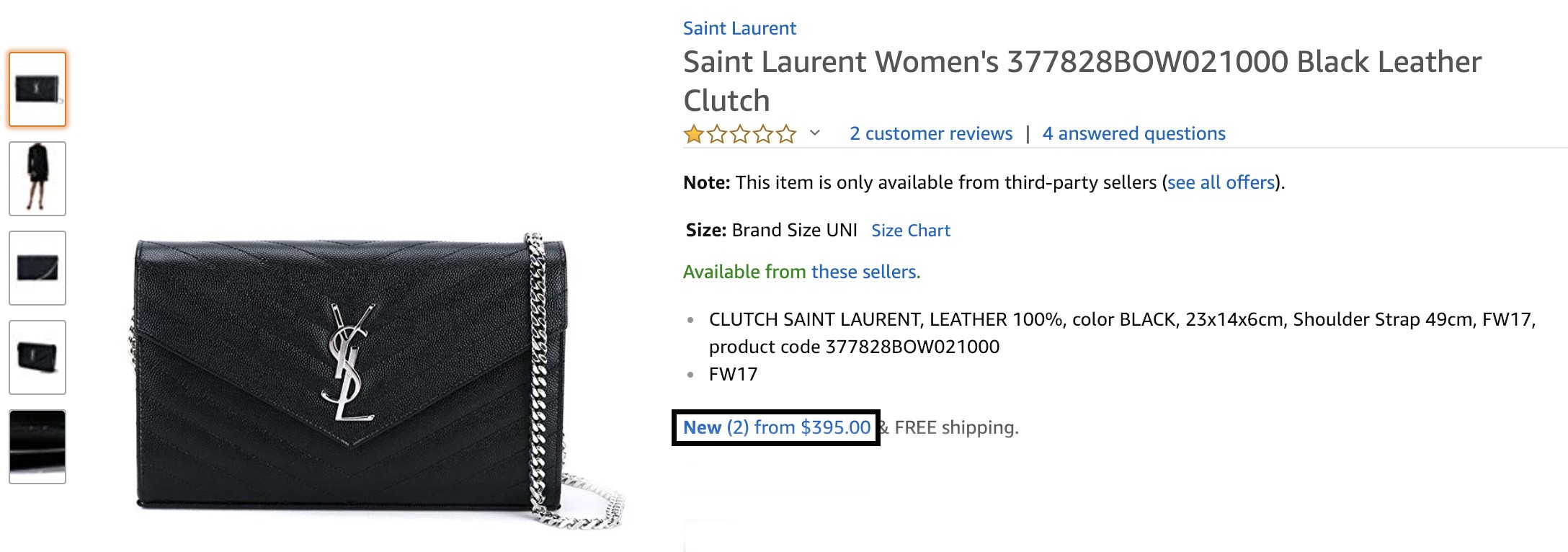 The authentic version of this YSL bag would sell for $1350
The authentic version of this YSL bag would sell for $1350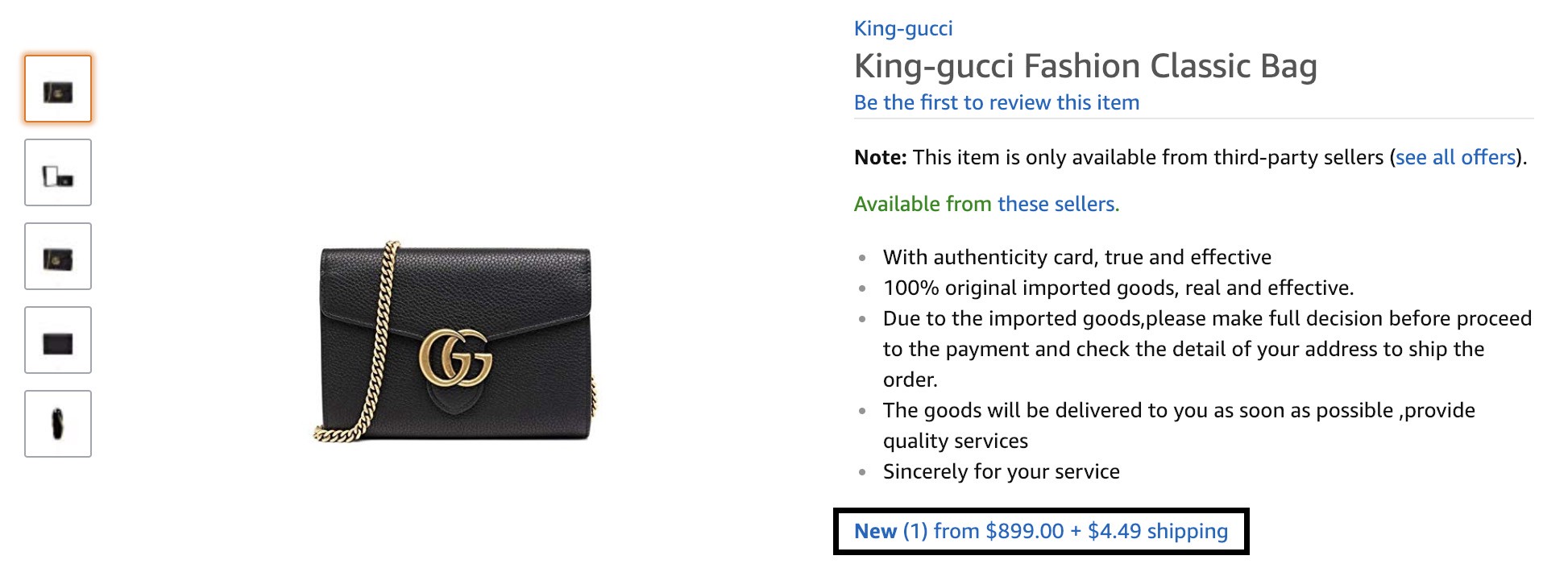 No mention of the name of the bag, red flags and typos throughout the product description and the authentic version sells for $1450
No mention of the name of the bag, red flags and typos throughout the product description and the authentic version sells for $1450
Fakes on Instagram
In 2016, a report on fakes on Instagram found that one fifth of 750,000 posts about top fashion brands feature counterfeit and/or illicit products. At the time, the article identified 20,892 Instagram accounts selling fakes, which has only increased by now. Every day, a dozen accounts selling replicas follow me on Instagram.
Some of the fakes look just like the real thing, with authentic-looking labels and quality product photography ? or they steal images from the thousands of handbag collectors accounts like @jerushacouture or @minks4all, two of the most popular handbag influencers.
These accounts attempt to fly under the radar and confuse costumers by using obtuse and obscure language to pose as ?personal shoppers? or offer ?discounts for bulk orders? (wholesale). They have their phone numbers in their bios or on posts for WhatsApp or WeChat (a popular messaging service in China), and use terms like ?1:1?, ?AAA? or ?designer quality? to indicate that they?re selling ?top-quality? fakes. They use hashtags like #replica (which is slightly less obvious than fake or counterfeit, apparently), and they also use brand hashtags like #Gucci and #Chanel. Many have also started using hashtags started by social influencers to further confuse customers like #jerushaaddict.
Avoid buying a designer bag on Instagram or WatsApp. These accounts usually don?t say very much about the products but will use vague terms like ?1:1 Replica Copy? or ?High Quality Brand?.
Again ? it?s illegal to sell counterfeits.If you see an Instagram account that looks like they?re selling fakes, report them to Instagram right away. Instagram can removes the pages of accounts aiming to sell designer fakes, but as soon as as their account is closed down, they create another. Instagram doesn?t have an option for reporting illegal sales of counterfeit luxury goods ? but they probably should.
Counterfeit seller profile on Instagram
Notice that they make no mention of actual brand names (Chanel, Louis Vuitton), but instead only show you a picture of a bag that looks identical to well known Chanel and Louis Vuitton bags.
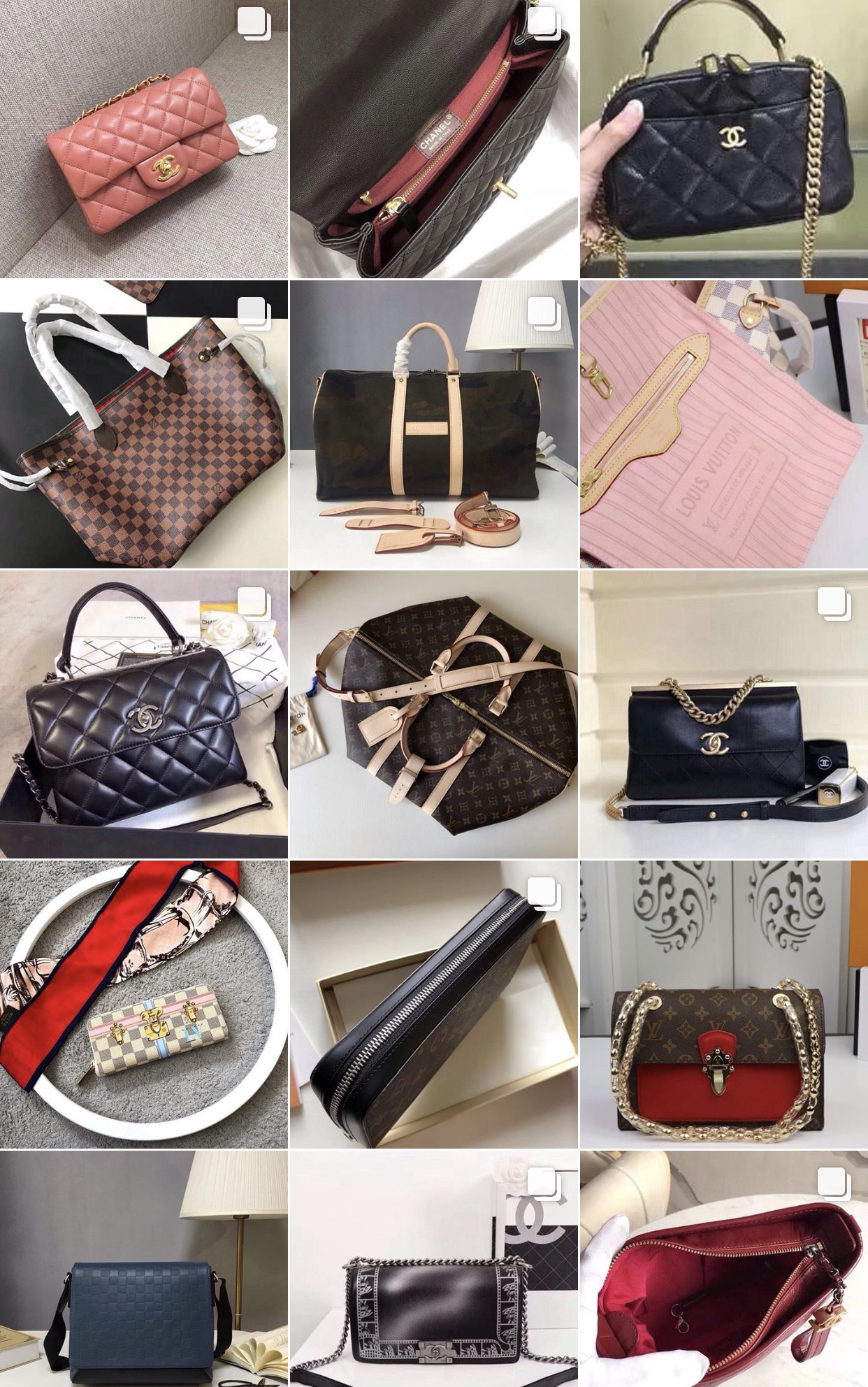
 Instant Red Flags: Ugly photos. Affordable Luxury Designer brand collections. Imported from Europe/Korea/South Africa.
Instant Red Flags: Ugly photos. Affordable Luxury Designer brand collections. Imported from Europe/Korea/South Africa.
So. Many. Fakes.
We already know there are counterfeit handbags out there ? even super fakes or AAA fakes (that?s what we in the industry refer to as ?really, really good fakes?). While distinguishing a fake from a real handbag used to be a fairly straightforward and easily Google-able process, it?s now incredibly difficult to tell real from replica.
Fakes are getting better and better, too. Even professional handbag authenticators (which is a real thing too, btw, see RealAuthentication or the wide variety of ?Authentic This? sub-threads on PurseForum), can be fooled by faux Hermes Birkin bags.
Rumor has it that on some counterfeit bags, parts are taken from real designer bags and put onto fake bags ? a combination of real and fake ? to confuse consumers.
It gets even worse: counterfeiters use branded boxes that look like the real thing, dust bags in the same color, they even copy paper tags and make fake receipts to fool consumers. For example, every authentic Chanel handbag comes with a hologram serial number sticker inside and a plastic authenticity card with the matching serial number. Counterfeiters have been known to steal/Photoshop images of hologram stickers from resellers and pass them off as fake, or, even worse, create their own hologram stickers.
How To Spot A Fake
Unfortunately, this isn?t an easy question to answer. Because we?re dealing with luxury designer goods that are made by heritage brands with many years of selling handbags/shoes/jewelry, every item has different and unique qualities ? design, leather, hardware, and branding may differ from season to season.
Authenticating luxury goods is both an art and a science, and requires YEARS of in-depth knowledge and hands-on experience. Luxury brands hand-make pieces and details, materials, leather types/colors vary by season and sometimes by week depending on what?s available in their artisan workshops. Louis Vuitton bags, for example, labels every bag with the week and year it was created.
One of the biggest indicators of fake bags is the price. While designer bags can be discounted during a Nordstrom Half-Yearly Sale or at a TJ Maxx, for example, they are never marked down to rock-bottom clearance prices. For example, if you see a Louis Vuitton bag being sold for $50, it?s fake. Prices for a real Louis Vuitton bag, even pre-owned, usually start at around $800. Any seller that claims to have designer bags at too-good-to-be-true prices, it probably is.
The Designer Authentication Pass/Fail Test
In my experience with designer handbag authentication, there?s a pass/fail test. If an item passes every test, it could be deemed authentic. In this line of work, any seed of doubt could mean the item is counterfeit.
Sometimes the only subtle difference between a counterfeit and a real Chanel bag is a flathead screw.
Pass/Fail Authenticity Checklist
- Smell
- Style and Shape
- Leather, Fabric, and Quilting
- Color, Pattern, Patina or Finish
- Stitching
- Hardware (zipper, lock)
- Branding (logos, stamps, tags)
- Date Code/Serial Number
Step One ? SMELL. How does it smell? Does it smell like luxury or does it smell like plastic?
Step Two ? STYLE AND SHAPE. Is it consistent with the real thing?Did the brand make ever this item in this style, shape, and size? If applicable (i.e. you know the year it was made), is the style consistent with the year it was made? During this step, examine the edging and corners of a bag, which are typically hand-painted by artisans, may be uneven and splotchy on a fake.
For example, counterfeit bags may be offered in colors or styles that were never made. Like, Louis Vuitton has never made their signature tote, the Neverfull, in grey and black check print (called Damier Graphite). I?ve seen combinations of handbags that were never made and replicas of Chanel bags that only appeared on the runway. Don?t believe sellers who try to claim that the unusual design is simply rare.
Step Three ? MATERIAL. Closely examine the leather, fabric, or quilting. How does it feel? Fake bags use lower quality materials and fabric. Counterfeiters may use fake leather that feels like plastic instead of being soft and supple like real leather. It might even smell like plastic.
Step Four ? COLOR. Closely examine the color, pattern, patina or finish. What color is the leather or pattern? Is the pattern correctly lined up? Does the patina look natural and not plasticky? Is it consistent with the real thing?
Step Five ? STITCHING. Examine the stitching and the lining. Authentic designer bags have tight, evenly-sized and spaced stitches. Replica bags have loose workmanship, uneven or crooked stitches, or even missing stitches where fabric is glued rather than sewn.
Step Six/Seven ? HARDWARE & BRANDING. These two can be checked at the same time because branding is usually on hardware anyway. Most designers will attach logo plates or logo imprints to their bags, which should be crisply printed or etched, while fake logos may be blurry or fuzzy. The branding on packaging should be consistent with the real thing too. Keep in mind that most brands change their branding every so often, which leads to small changes in design. Check all brand stamps and logo markings; the differences between a real and a fake Chanel bags could be nuanced ? for example, a counterfeit Chanel Classic Jumbo Flap Bag might be stamped inside MADE IN PARIS instead of MADE IN FRANCE.
Authentic hardware should be sturdy and feel secure; fake hardware is usually flimsy with too yellow or too shiny plating. These details are very subtle (a logo being off by a millimeter, or a screw head is the wrong shape; counterfeiters attempt to copy clasps, screws, and other hardware details to perfection. Sometimes the only difference between a counterfeit and a real Chanel bag is a flathead screw.
Step Eight ?DATE CODES & SERIAL NUMBERS. These differ based on every brand. Chanel bags have hologram serial numbers that match with a separate authenticity card, while a Louis Vuitton bag has a date code to indicate the factory code and date it was manufactured. That said, just because an item has a date code does not guarantee that it?s authentic since many counterfeit items have date codes. A valid and properly stamped date code or serial number is just one of many parameters that are checked to guarantee the authenticity of a designer handbag.
There are a million other factors to authentication, down to season specific details between hardware, leather, brand logos, packaging (yes, counterfeiters make fake shopping bags). I could probably go on for another twenty pages about this.
How Can You Protect Yourself From Buying Fakes?
Shopping for pre-owned luxury items isn?t easy and nothing will ruin your day faster than finding out that the handbag you bought turns out to be a replica.
How to completely avoid buying counterfeit luxury goods: always purchase from an authentic brand boutique (a Louis Vuitton store) or a licensed retailer (Neiman Marcus, Saks Fifth Avenue, Barneys, Net-a-Porter).
Another way to avoid buying counterfeit luxury goods: buy from a trusted online site that promotes authenticity, has a guarantee about authenticity and a ?no questions asked? return policy. There are stores online that guarantee the authenticity of their items (to the best of their ability) to protect you from buying fakes. Luxury resellers that I trust for pre-owned luxury goods:
Yoogi?s Closet
Fashionphile
Rebag
Bag Borrow or Steal
The RealReal
Avoid buying a designer bag on Instagram or WatsApp. These accounts usually don?t say very much about the products but will use vague terms like ?1:1 Replica Copy? or ?High Quality Brand?.
Beware of websites which are using keywords that include phrases like:
- Cheap Louis Vuitton
- Louis Vuitton Sales
- Louis Vuitton Outlet
Pay attention to the URL: Buy from LouisVuitton.com, but NOT LouisVuittonOutlet.com. There is no such thing as a Louis Vuitton outlet (however Gucci does have outlet stores).
If the reseller has a website, and check the contact page. Be wary of websites that do not have an office address, phone or email available. If you?re unsure, research them and try to read reviews online.
Also, check the resellers? method of payment. PayPal is a safe way for a client use for an online purchase ? rather than wiring them money ? because PayPal will protect you.
Third-party authentication is a new business model sprouting up, promising to authenticate luxury goods for a price. The third-party authenticators that have good reputations are: Real Authentication and Entrupy.
A small caveat about authentication services and even buying secondhand: authenticity is based on that ?authenticators? opinion of what they may have or have not seen in the past. There is no school, education or training to become a designer handbag authenticator (but maybe I should start one?).
8 Reasons You Should NEVER Buy Counterfeit Luxury Goods
- They?re illegal. Counterfeiters are stealing intellectual property by violating copyright and trademarks.
- They?re illegal, again. In the U.S., federal law makes it illegal to knowingly sell counterfeit goods, which includes the production, sale and transport. In some countries, it?s a crime to be in possession of fakes, which may result in fines or even prison time.
- Counterfeiting funds organized crime and terrorism.
- Counterfeiting funds child labor.
- Counterfeiting funds human trafficking.
- LVMH and Kering (the conglomerates behind the major fashion houses) spend a lot of time and money fighting back against counterfeiting. It?s estimated that $82 billion of sales will be lost due intellectual property infringement. Christian Louboutin, whose famous red-soled shoes are prime fake targets, has set up a ?Stop Fakes? campaign where they monitor social media to find counterfeit sellers, and ?take them down.?
- Fake bags are tacky. Most people who know handbags/designers will know a counterfeit is a fake, even if it?s a good one.
- Counterfeit handbags will fall apart, tear, crack, and stitches may come lose. The contents of the bag will fall onto the ground and roll down the streets along with its carriers dignity.
Why Do People STILL Buy Counterfeit Goods, Anyway?
There are two kinds of buyers:
- Fooled by fakes. ?I honestly didn?t know it was fake,? someone sent me in a DM on Instagram after being fooled by a seller on Instagram using obtuse language like ?genuine luxury bags? or showing images of designer items with no details, only WatsApp contact info. I?ve seen everything from counterfeit Louis Vuitton wallets, limited edition Chanel Boy bags, fake Rolex watches to fake Off-White shoelaces on Instagram.
- Know it?s a knock-off, but don?t care. ?I?m not paying that much money when the fake is just as good,? and they are typically trend buyers. They think they are paying way too much for the brand name, and it has no real indicator of quality. Many people buy replicas because they can?t afford the real thing, or they want to impress people by carrying a well-known or trendy bag.
The internet and social media are rampant with counterfeit goods ? there are more places than ever to shop and show off fashion, and many criminals target the same customers as luxury-goods makers themselves. Many shoppers who purchase counterfeit handbags, accessories and shoes don?t actually know they are buying fakes and believe they are getting the real thing at a really good deal. Or maybe they just want the next trendy thing and don?t care. Fashion, amiright?
What To Do If You Already Have A Counterfeit Bag
This is an ethical dilemma I?ve thought a lot about. It?s okay. I?m not actually the moral police, despite my holier-than-thou attitude about designer bags. It?s important to note that if you already own a counterfeit item, you are not committing a crime ? it?s illegal to sell counterfeit goods. Were you given a counterfeit bag as a gift? Or maybe you decided to buy one because it was inexpensive and you liked the design? Maybe you got fooled into spending a few hundreds or thousands of dollars on something you thought was real, only to find out that it wasn?t. Or maybe you spent a couple hundred bucks to buy a bag that looks like a fake Hermes Birkin because you wanted the status that bag can bring you. Or maybe you just like it. That?s fine.
In France, a person found with counterfeit merchandise has to pay a high fine for the crime.
Unfortunately, there are already a lot of fake bags in circulation. If you have a replica bag, you can write fake or counterfeit on the inside of the bag and donate it. This way, you?re giving it to someone less fortunate, and it gets the bag out of the resale market where it can?t be resold.
I don?t think they should be thrown out in the garbage because that just adds waste to landfills. Luxury reseller Fashionphile had a YouTube marketing campaign years ago called Kill Your Fakes, where they encouraged customers to light their fake bags on fire or shoot them.
A recent report by The Fashion Law exposed that each year, tens of millions of perfectly wearable and carry-able counterfeits are left in the custody of brands and government agencies. While they could be donated to people that need bags, these entities have other plans for the immoral items. No matter how high quality or attractive the counterfeit accessories and bags are, they are destroyed, either by incineration or industrial-strength shredding.
?They?re counterfeits ? what else can we do with them? We are required to destroy [counterfeits] by law,? says John Sandweg, the former acting director of the federal Immigration and Customs Enforcement division.
For press inquiries, contact [email protected]
Read more about authenticity, designer handbags, and the resale market, follow my blog at coffeeandhandbags.com.
References:
The International AntiCounterfeiting Coalition, also known as the IACC, is the world?s largest non-profit organization that is solely devoted to protecting intellectual property and to completely stop counterfeiting.
Amazon needs to get a handle on its counterfeit problem
‘Fulfilled by Amazon’ should be a badge of trust, not a legal loophole. When Amazon is questioned about it, it tends to?
www.engadget.com
http://www.thefashionlaw.com/home/is-amazon-complicit-in-the-widespread-availability-of-counterfeit-goods-on-its-plawtform
http://www.thefashionlaw.com/home/what-happens-to-the-billions-of-dollars-of-counterfeits-seized-every-year
